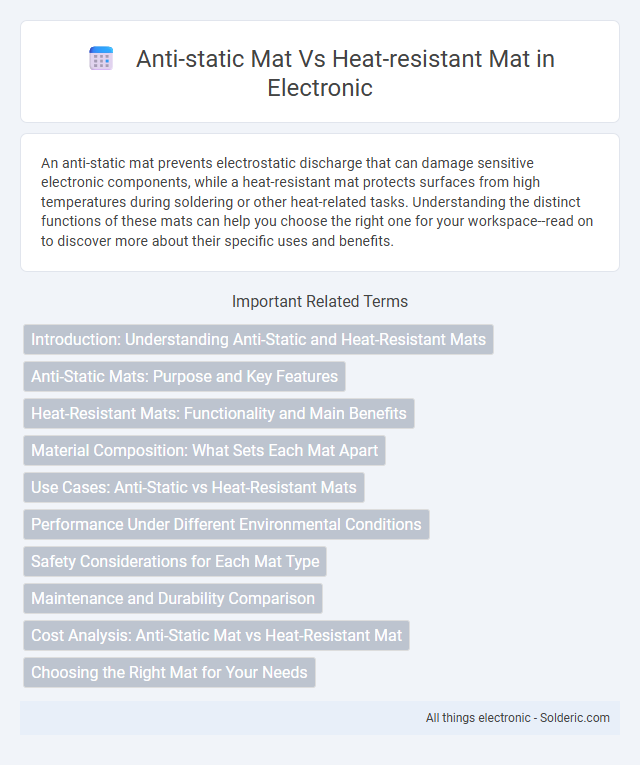An anti-static mat prevents electrostatic discharge that can damage sensitive electronic components, while a heat-resistant mat protects surfaces from high temperatures during soldering or other heat-related tasks. Understanding the distinct functions of these mats can help you choose the right one for your workspace--read on to discover more about their specific uses and benefits.
Comparison Table
| Feature | Anti-Static Mat | Heat-Resistant Mat |
|---|---|---|
| Purpose | Prevents electrostatic discharge (ESD) | Protects surfaces from high temperatures |
| Material | Conductive or dissipative rubber/plastic | Silicone, fiberglass, or heatproof rubber |
| Typical Use | Electronics assembly, repair stations | Cooking, soldering, industrial applications |
| Temperature Resistance | Up to ~70degC (varies) | Up to 250degC to 500degC or higher |
| Static Control | Yes - dissipates static electricity | No - not designed for static control |
| Surface Texture | Smooth or slightly textured for grounding | Heatproof with non-slip texture |
| Durability | Moderate, focused on static protection | High heat and wear resistance |
| Cost | Generally lower | Generally higher due to heat resistance |
Introduction: Understanding Anti-Static and Heat-Resistant Mats
Anti-static mats dissipate static electricity to protect sensitive electronic components during handling or assembly, making them essential in electronics manufacturing and repair environments. Heat-resistant mats withstand high temperatures, providing a safe workspace for soldering, welding, or handling hot tools without damage or safety hazards. Your choice depends on whether you need protection from static discharge or heat exposure to ensure equipment safety and durability.
Anti-Static Mats: Purpose and Key Features
Anti-static mats are designed to prevent electrostatic discharge (ESD) by safely dissipating static electricity from electronic components and work surfaces, ensuring the protection of sensitive devices. Key features include conductive or static-dissipative materials, grounded connectors, and durability to withstand repetitive use in electronics assembly, repair, and cleanroom environments. These mats are essential in reducing the risk of damage caused by static electricity in high-tech manufacturing and repair settings.
Heat-Resistant Mats: Functionality and Main Benefits
Heat-resistant mats provide excellent protection for work surfaces against high temperatures, preventing damage from soldering irons, hot tools, and molten materials. Their main benefits include durability under extreme heat, enhanced safety during thermal processes, and reduced risk of burns and fire hazards. You can rely on these mats to maintain workspace integrity and extend the lifespan of your tools and equipment.
Material Composition: What Sets Each Mat Apart
Anti-static mats are primarily made from materials like polyurethane or vinyl embedded with conductive carbon or metal fibers, designed to dissipate static electricity effectively. Heat-resistant mats, on the other hand, utilize silicone, fiberglass, or specialized rubber compounds capable of withstanding high temperatures without degrading. The distinct material compositions directly influence their specialized functions, with conductivity and static control defining anti-static mats, while thermal insulation and durability characterize heat-resistant mats.
Use Cases: Anti-Static vs Heat-Resistant Mats
Anti-static mats are essential in electronics assembly and repair environments to prevent electrostatic discharge that can damage sensitive components. Heat-resistant mats are designed to withstand high temperatures, making them ideal for soldering stations and industrial applications involving hot tools or materials. Choosing between these mats depends on whether the primary need is static protection or thermal resistance, ensuring a safe and efficient workspace for specific tasks.
Performance Under Different Environmental Conditions
Anti-static mats maintain their effectiveness by dissipating static electricity consistently across varying humidity and temperature levels, preventing electrostatic discharge in sensitive electronic environments. Heat-resistant mats excel at withstanding high temperatures without degrading or releasing harmful fumes, making them ideal for soldering stations or industrial processes involving heat exposure. In environments where both static control and thermal resistance are critical, selecting a mat with combined properties or layering mats ensures optimal performance and protection.
Safety Considerations for Each Mat Type
Anti-static mats are designed to dissipate static electricity, reducing the risk of electrostatic discharge that can damage sensitive electronic components, making them essential in electronics workspaces. Heat-resistant mats provide protection from high temperatures, preventing burns and surface damage when working with hot tools or materials, crucial in soldering or crafting environments. Your choice should prioritize the specific safety risks of your tasks, ensuring protection from either electrical hazards or thermal injury.
Maintenance and Durability Comparison
Anti-static mats require regular cleaning with specialized anti-static solutions to maintain their conductivity and effectiveness, while heat-resistant mats demand periodic inspections for heat damage or warping to ensure safety and performance. Durability of anti-static mats can degrade over time with exposure to oils and chemicals, whereas heat-resistant mats typically withstand high temperatures and physical wear better but may crack or lose structural integrity if exposed to extreme thermal shock. Proper maintenance tailored to each mat type significantly enhances lifespan and functional reliability in industrial or electronic environments.
Cost Analysis: Anti-Static Mat vs Heat-Resistant Mat
Anti-static mats generally cost less than heat-resistant mats, with prices varying based on size and material quality; anti-static mats typically range from $20 to $50, while heat-resistant mats can cost between $40 and $100 or more. The higher price of heat-resistant mats reflects their ability to withstand extreme temperatures, making them a cost-effective choice for soldering and high-heat applications, whereas anti-static mats primarily protect electronic components from static discharge. Your selection should consider the specific requirements of your workspace, balancing initial investment against long-term durability and functionality.
Choosing the Right Mat for Your Needs
Selecting the right mat depends on your specific requirements: anti-static mats are essential for protecting sensitive electronic components by dissipating static electricity, while heat-resistant mats provide crucial protection against high temperatures during soldering or crafting activities. Consider the environment and tasks you perform regularly to determine if your workspace demands static control, heat resistance, or a combination of both. Ensure your chosen mat enhances safety and efficiency by matching its protective properties to your precise operational needs.
anti-static mat vs heat-resistant mat Infographic

 solderic.com
solderic.com